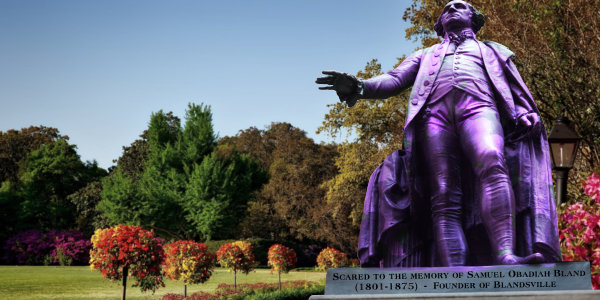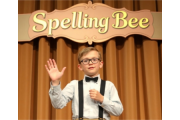See more Rock Tuff stories!
“I’m sure you believe in truth and justice, Mr. Tuff.”
I was glad she didn’t add God, motherhood, Queen, country, world peace, and a cure for cancer.
The woman in my office was middle-aged and wore a white sweater with a red maple leaf emblem and a blue skirt, and she sat, if it is possible, at attention. Her house was probably decorated with pictures of prime ministers and copies of the BNA Act and the Canadian Constitution of 1982. She probably played the National Anthem on her stereo fortissimo each morning and maybe raised a flag on her front lawn.
“I’m Polly Cora Ekt and I hope you’ll support my campaign to remove the statue of Mr. Bland from the main corner of our town.”
Blandsvillians, accustomed to the life-size bronze statue, seldom noticed it, but tourists sometimes photographed it. On the six-foot pedestal was a plaque which read “Sacred to the memory of Samuel Obadiah Bland (1801-1875), founder of Blandsville.” Actually it said “Scared,” misspellings not being restricted to our time. Recently the statue had sported a coat of pink paint, thanks to some protesters of some cause, but the colour was not significant; it was probably because a local hardware store was having a sale on that shade.
“Why do you want to remove Mr. Bland’s statue? He did found the town.”
“The man was immoral: he cheated the natives when trading for furs, he sold ‘firewater’ to them, which was against the law, and he fathered at least three illegitimate children by three poor women.”
Well, nobody’s perfect, I thought.
“Maybe you’d like to sign my petition.” I noticed that there were only six signatures, including Ms. Ekt’s, but maybe she had just started gathering support.
“Your name would help because I know you have a lot of respect in town.”
Usually I lap up flattery as a cat laps up cream, but I had seen the graffiti scrawled on the washroom wall of the high school, according to which I made the original Bland look like a saint.
“I’m afraid I don’t have a pen.”
“I do.”
“I’d like to wait. The last time I signed something too quickly, I ended up with a two-year supply of fertilizer for my lawn – and it killed the lawn.”
After Ms. Ekt left – no, marched out – I realized that I didn’t know much about Blandsville’s history, but does anyone? So I went to the Town Hall, where my former student, Carl Brown, works.
“How is your wife?”
“Fine.”
“And your dog?” (A Great Dane named Hamlet, of course.)
“Fine.”
“And how goes your research?” The Browns were trying to prove that Shakespeare’s plays were really written by Will’s son Hamnet, although the boy died when he was only eleven.
“We’ve put that project on hold until we can get to England to do proper research. Right now we’re working on the Confederation Poets.”
“Roberts, Lampman, Carman, and Scott.”
“That’s right. We have a theory that all of the poems were written by the same person.”
“Which one?”
“None of them. Actually Sir John A. MacDonald.”
“The founder of our country?”
“The same.”
Well, I thought, if he could create the second largest nation in the world, he could dash off a few hundred poems.
I explained the purpose of my visit and Carl, who was not busy, offered to help; in return I promised to buy a week’s supply of dog food for Hamlet.
We discovered a few interesting facts about Mr. Bland: he did employ some “unorthodox” business practices and he did have a number of children, legal and illegal. Most of them were male, so that we did not have to contend with name-changes caused by marriages.
“Here’s something,” said Carl. “One of his illegitimate sons, who was hanged for horse-stealing, had earlier fathered a son ‘on the wrong side of the blanket’ and that son’s descendants still live in Blandsville. One is a woman named Polly Cora Ekt.”
“I know her.” Thank you, Carl, and thank you, God, I thought.
From my office, I telephoned Ms. Ekt, explaining where she fitted on the Bland family tree and suggesting that, since no one knew what Samuel Obadiah looked like, we could replace the plaque with one for her ancestor; it could even mention her, but she did not seem eager for this honour, so the statue and plaque for Blandsville’s flawed founder still stand.
And the pink paint is slowly fading.





